CEO’s Office
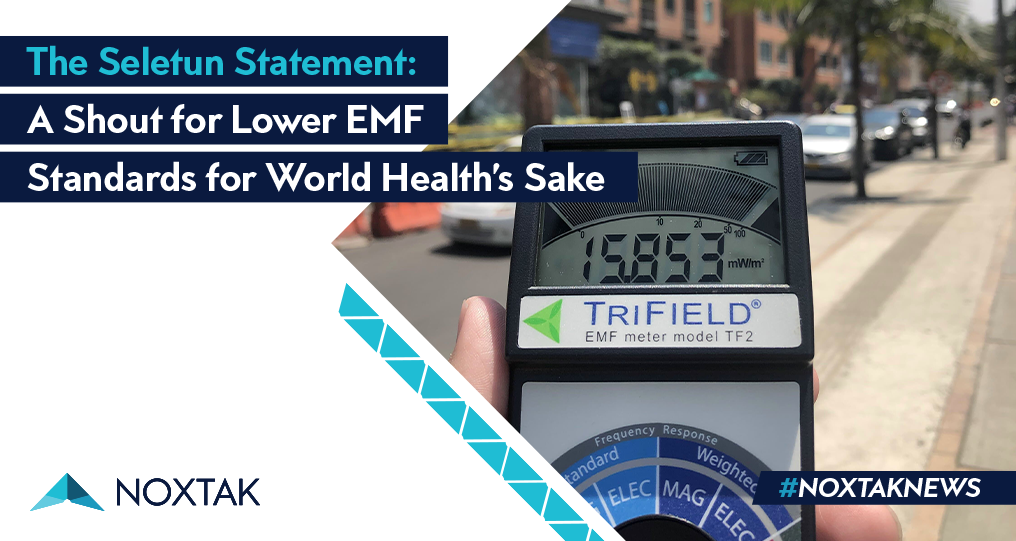
Abstract:
In November of 2009, a scientific panel met in Seletun, Norway, for three days of intensive discussion on existing scientific evidence and public health implications of the unprecedented global exposures to artificially polarized electromagnetic fields (EMF). EMF exposures result from the use of electric power and from wireless telecommunications technologies for voice and data transmission, energy, security, military, and radar use in weather and transportation.
The statement outlines some recommendations to help protect public health including adopting traditional public health principles and reducing EMF exposures now rather than waiting for proof or understanding of mechanisms; the establishment of an international registry to track time trends in incidence and mortality for cancers and neurological and immune diseases and also proposes that there should be mandatory pre-market assessments of emissions and risks before deployment of new wireless technologies.
Key questions:
Is this statement being correctly interpreted? What are the recommendations set by the scientific panel? Are those recommendations being applied properly? Which are the organizations targeted by this statement? What was the evidence presented? Is it possible to really change the norm? What are the steps to take in order to implement realistic safety limits?
The Seletun Scientific Statement represents the consensus conclusions of a scientific panel that has discussed the existing scientific evidence and potential public health implications of exposure to artificial electromagnetic fields (EMF) from telecommunications and electric power technologies.
The Scientific Panel, led by Olle Johansson, PhD of the Karolinska Institute, recognized that the body of evidence on EMF requires a new approach in order to protect public health; the growth and development of the fetus, and of children; and argues for strong preventative actions. New, biologically-based public exposure standards are urgently needed to protect public health worldwide.
According to the international scientists, it has become obvious that new, biologically-based public exposure standards are urgently needed to protect long-term public health worldwide. Current public-safety EMF-exposure guidelines used worldwide, based on physics models and calculations, currently only protect for damage generated by a heating effect. With respect to prolonged, low-intensity exposures that nowadays frequently occur, but do not have a heating effect, the guidelines, say the scientists, are inadequate and obsolete.
The report urges global governments to adopt significantly lower human exposure standards for electromagnetic fields. The scientists recommend specific exposure limits for different frequency fields, including microwaves, used in wireless communications, and ELF electric fields, and magnetic fields.
The Seletun Statement
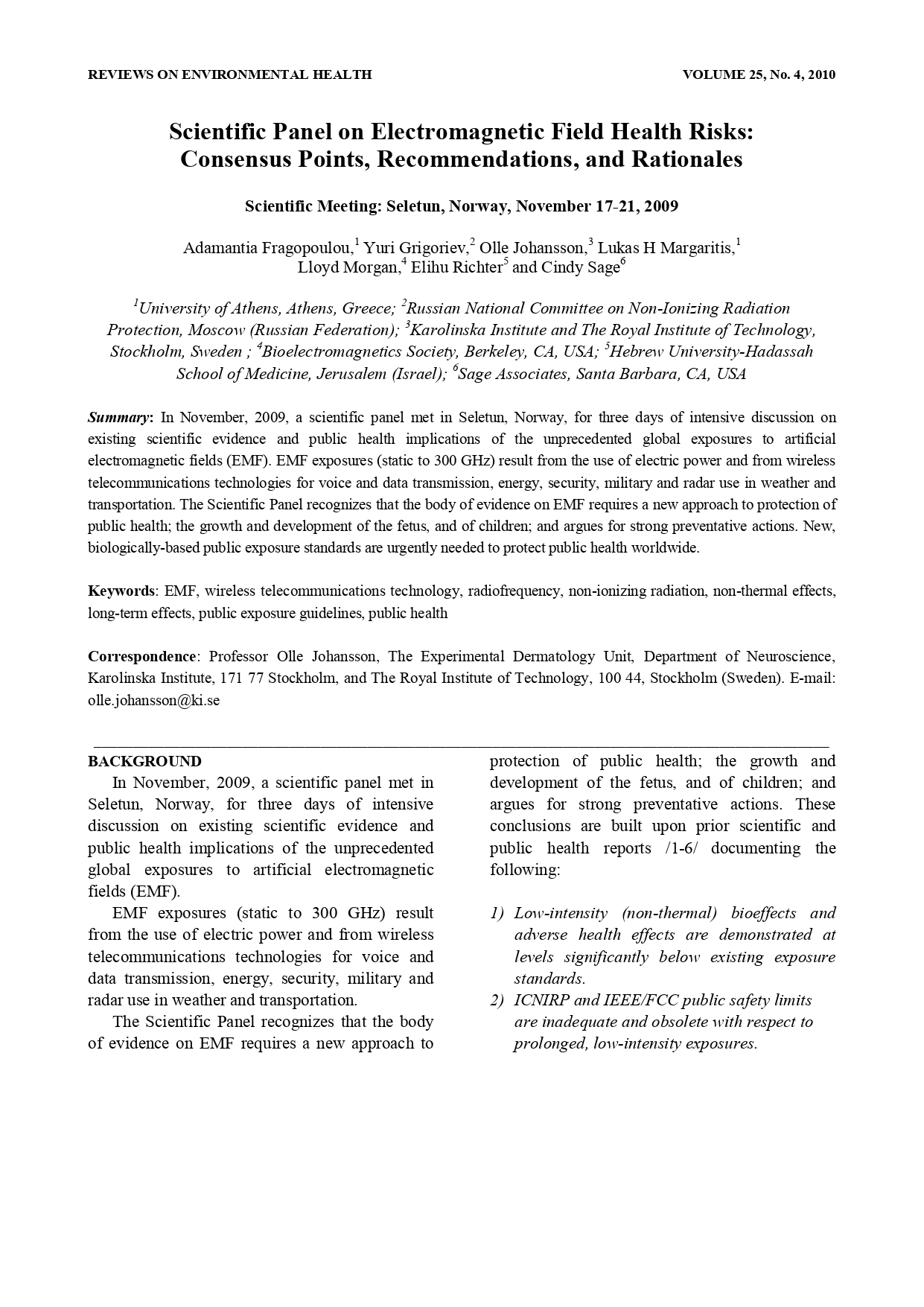
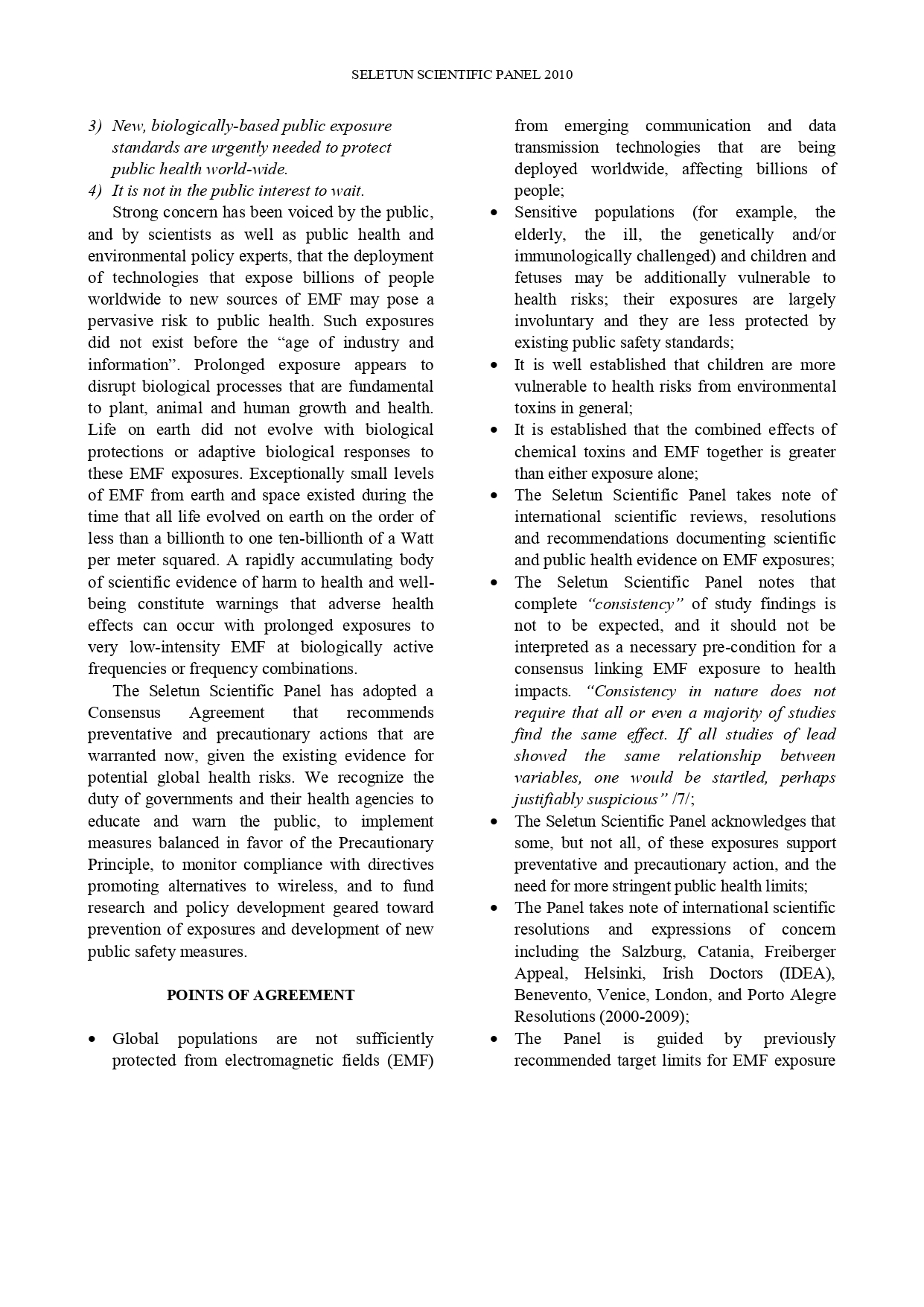
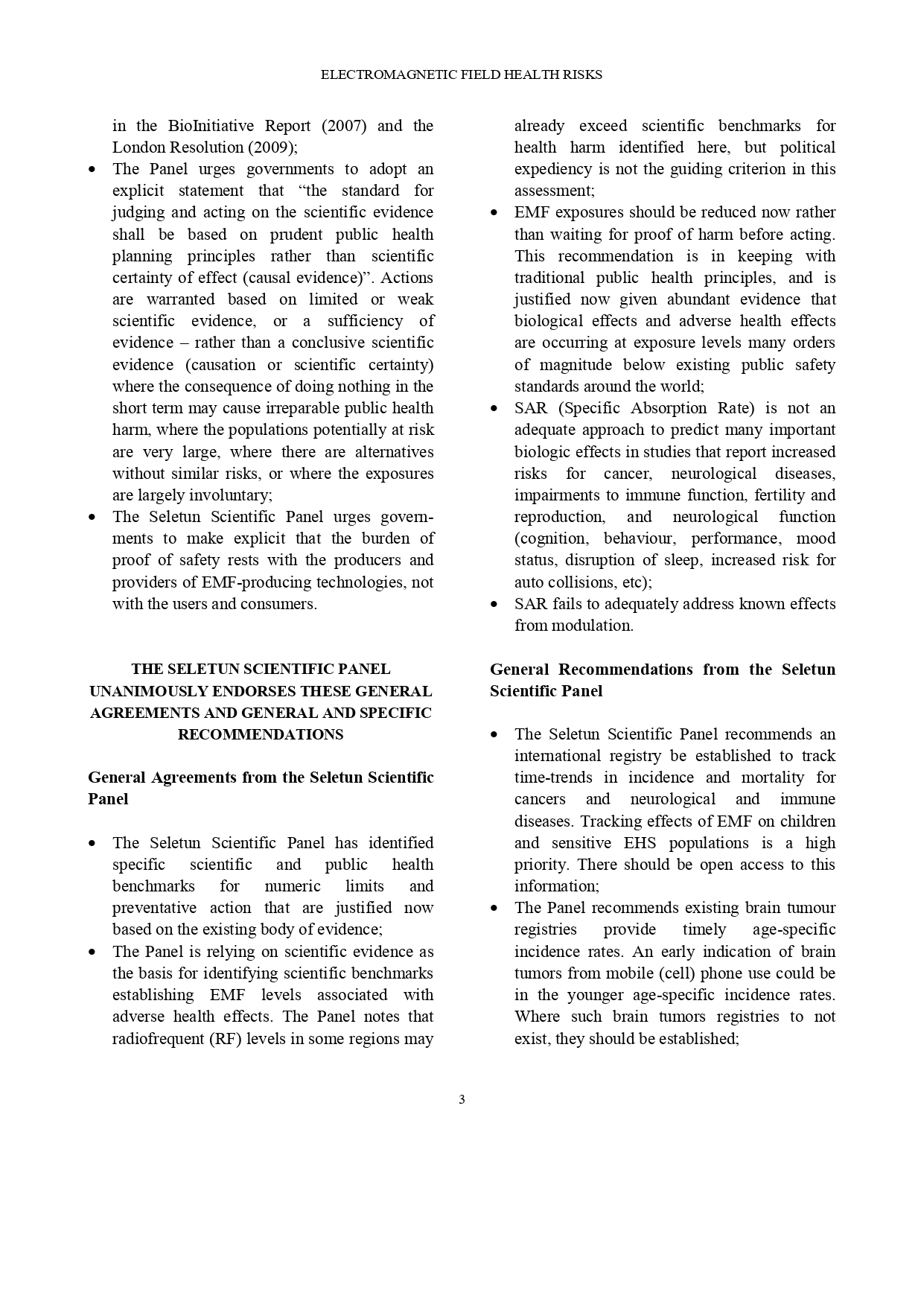
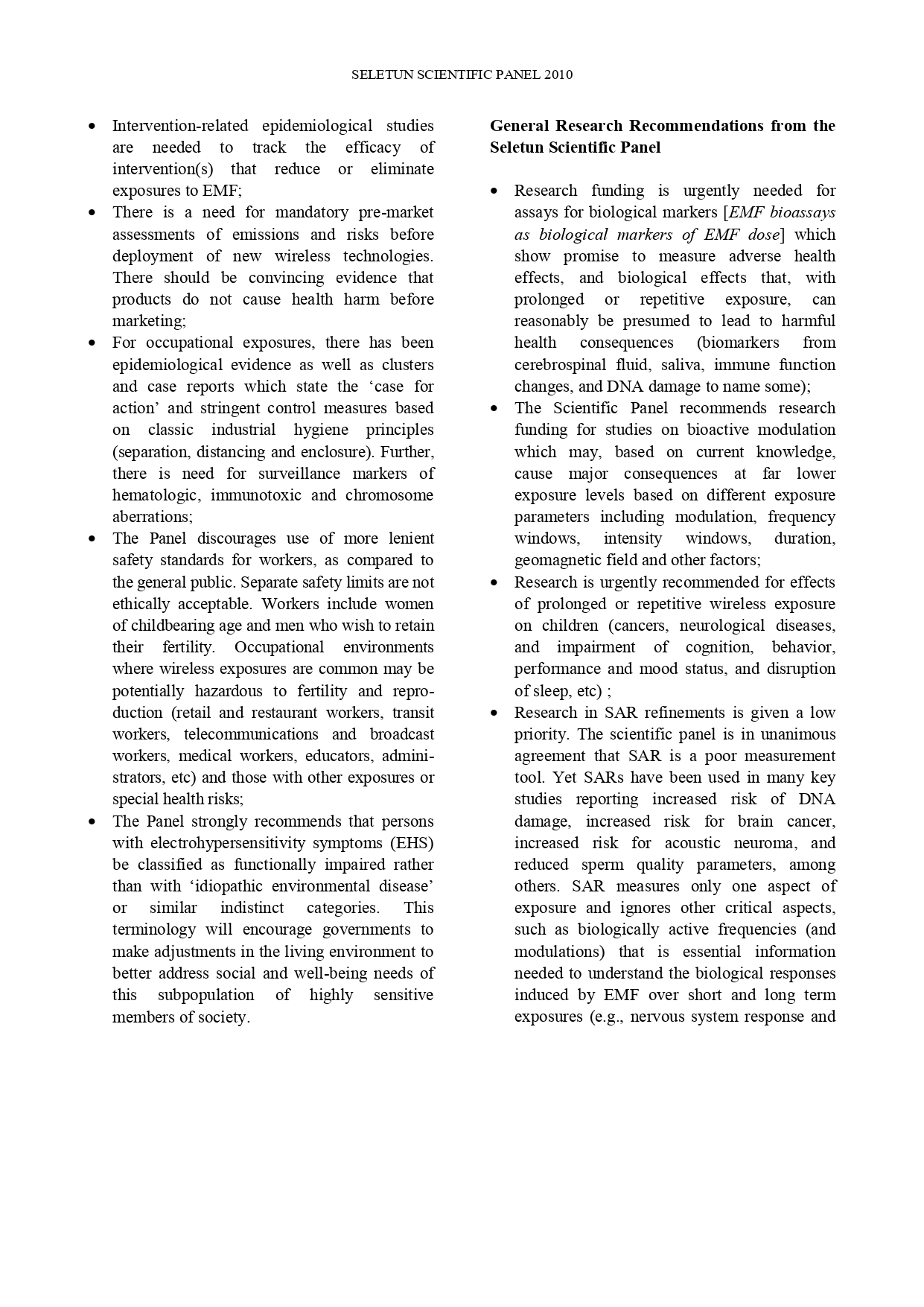
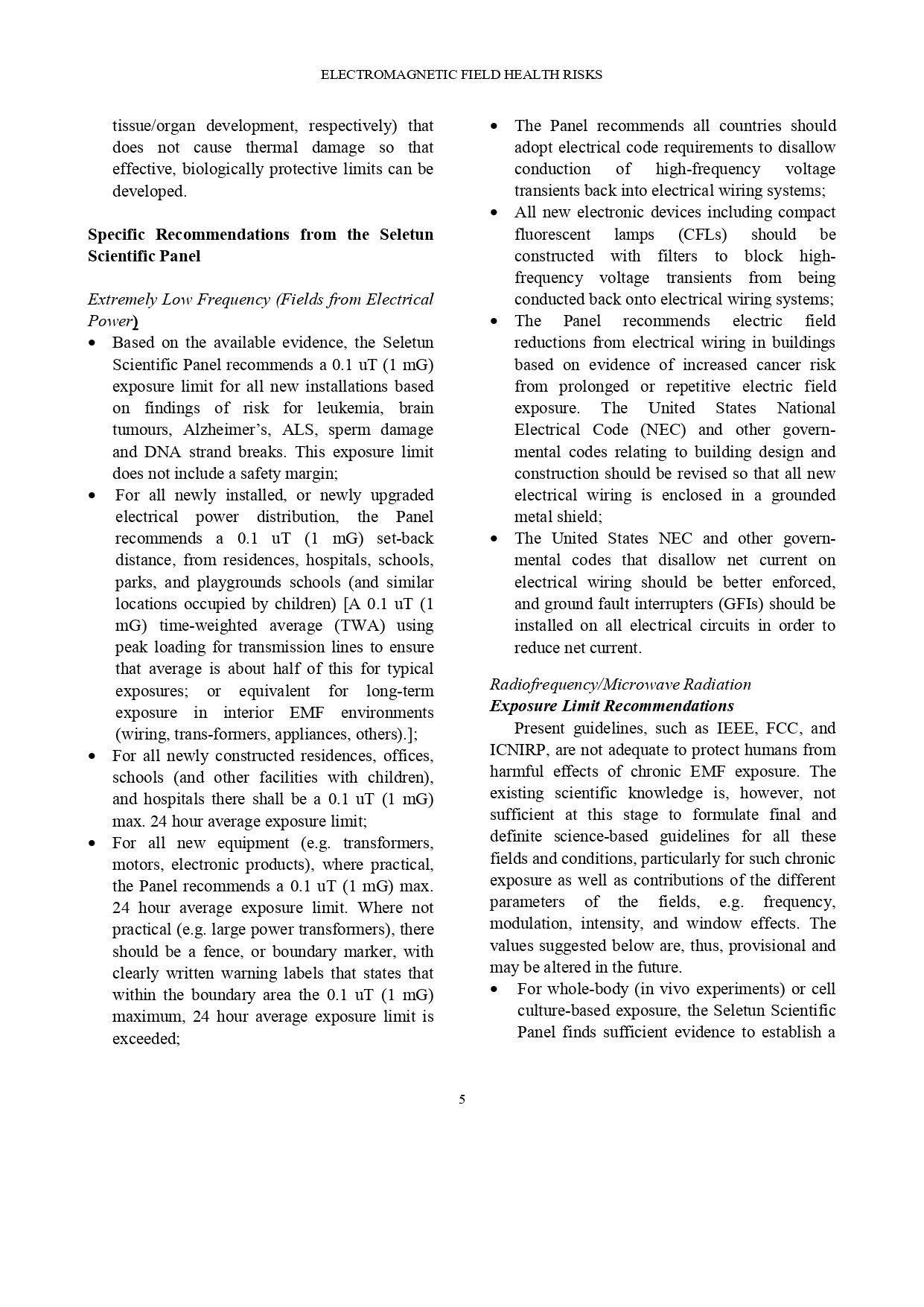
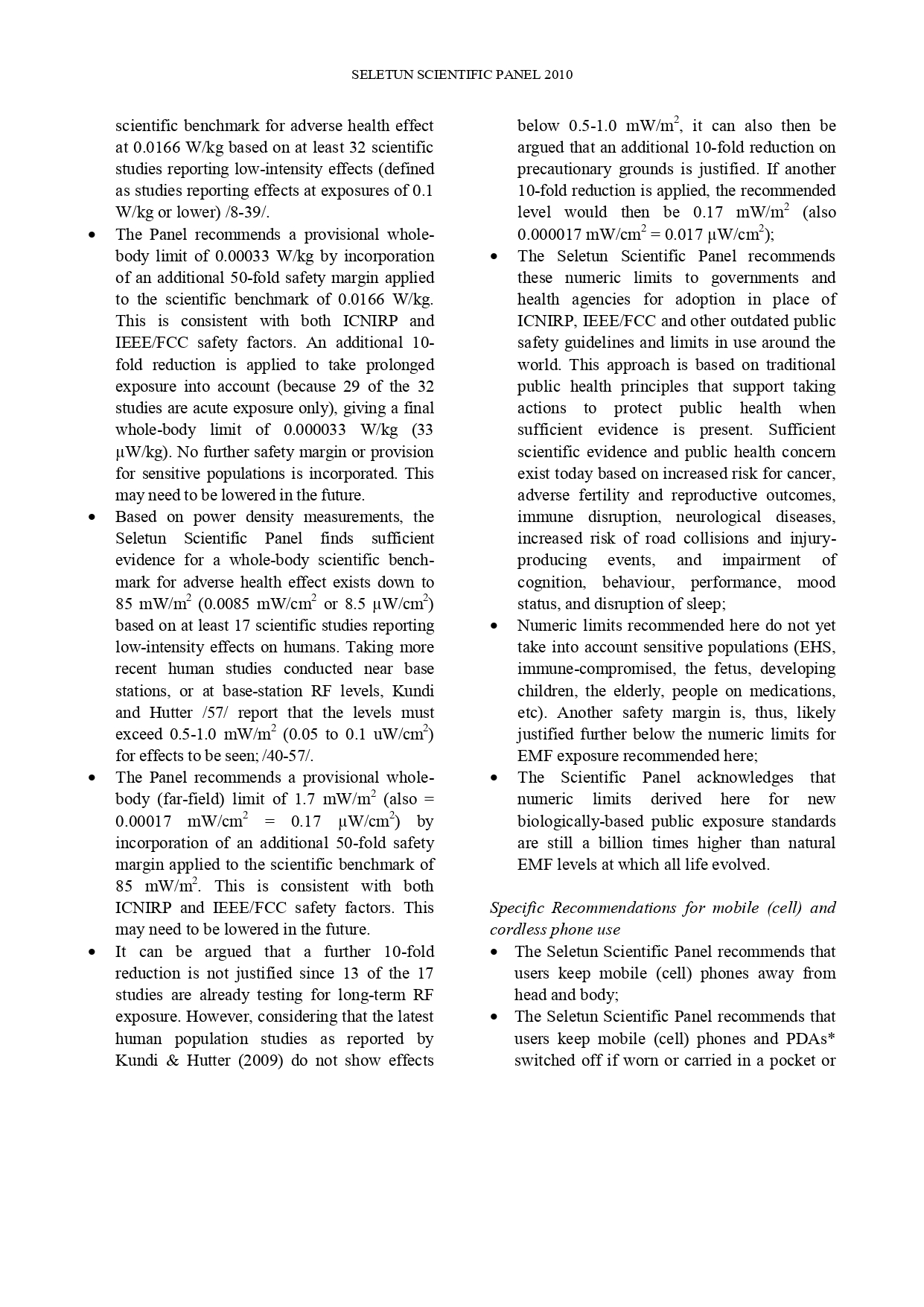
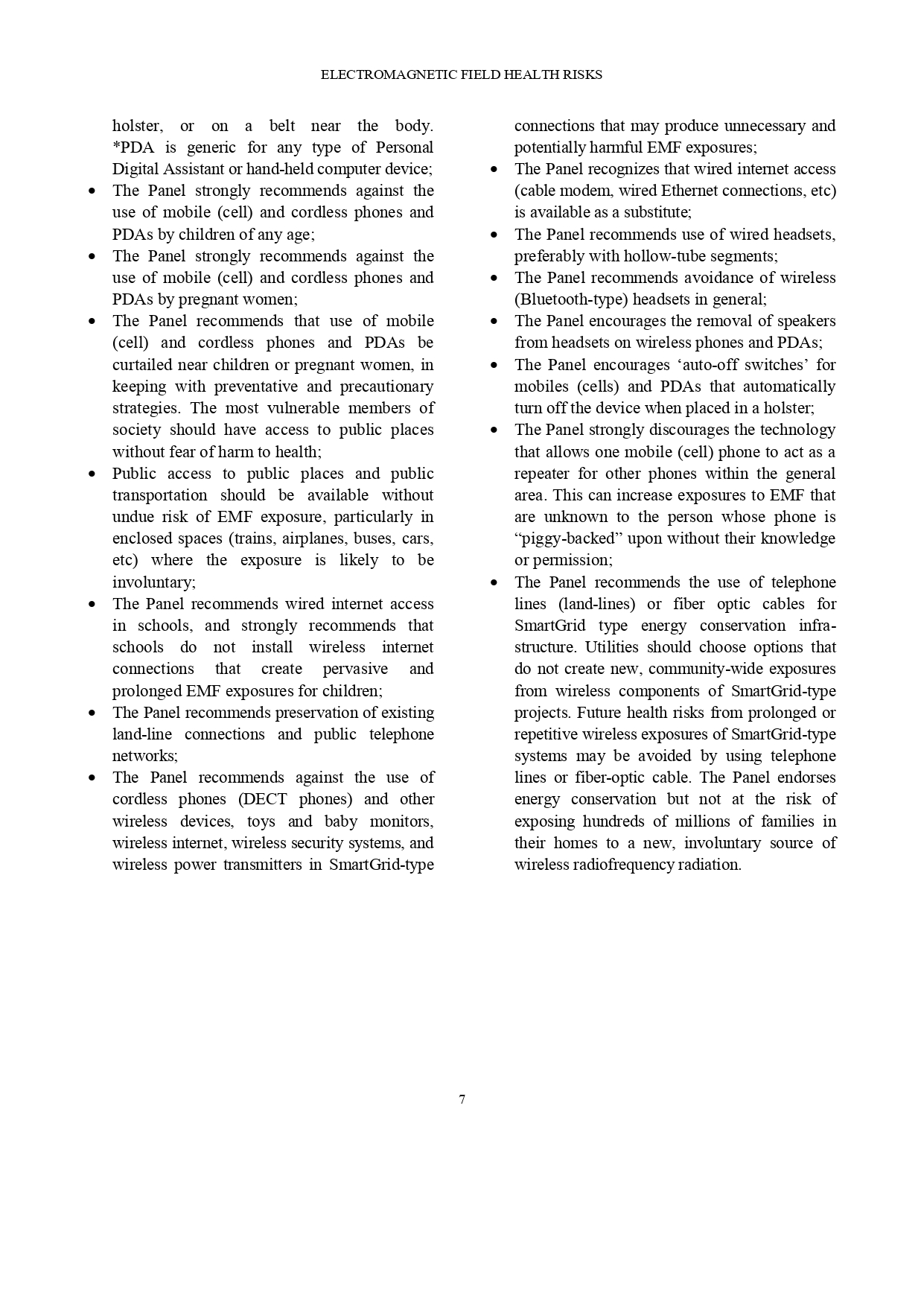
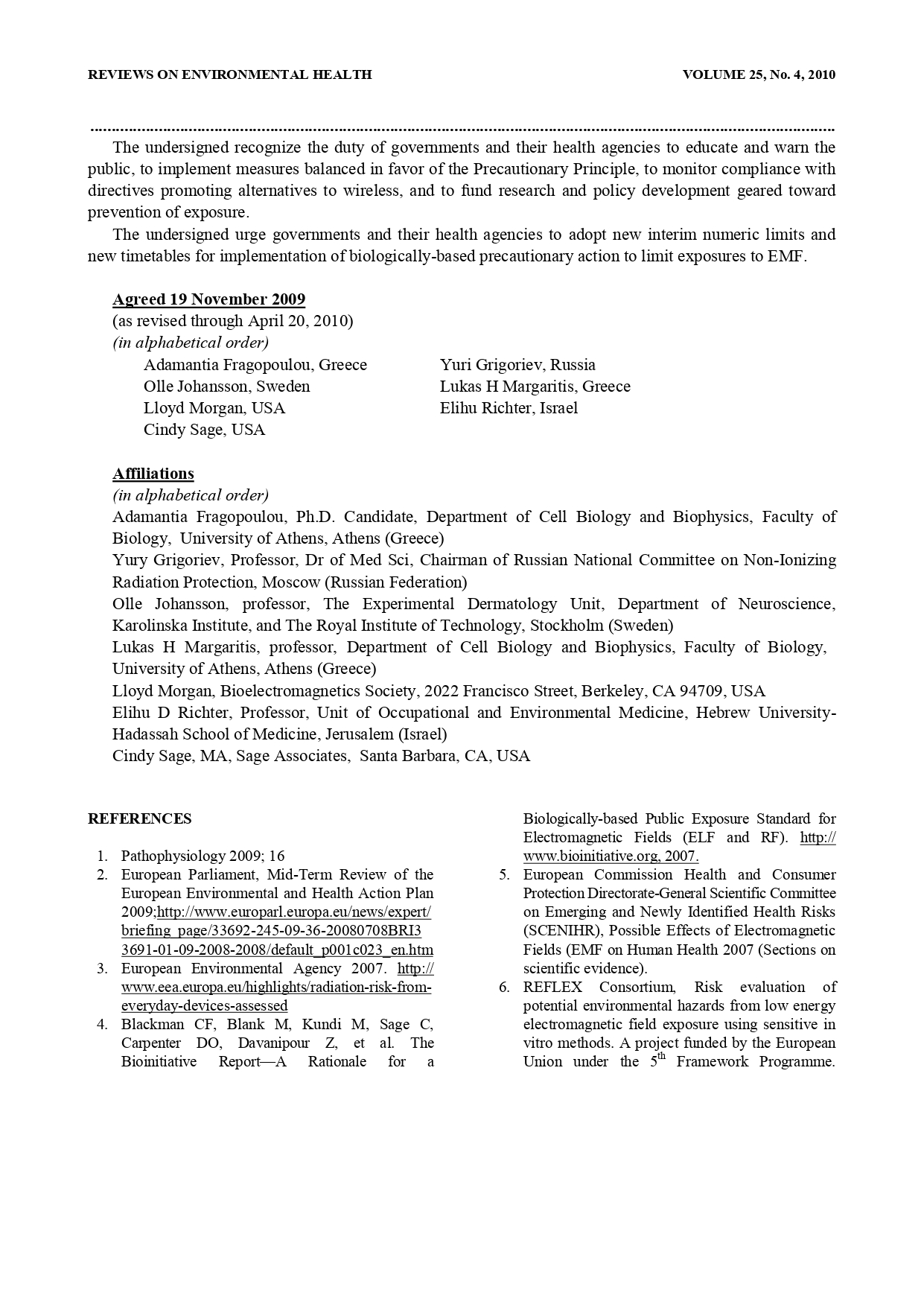
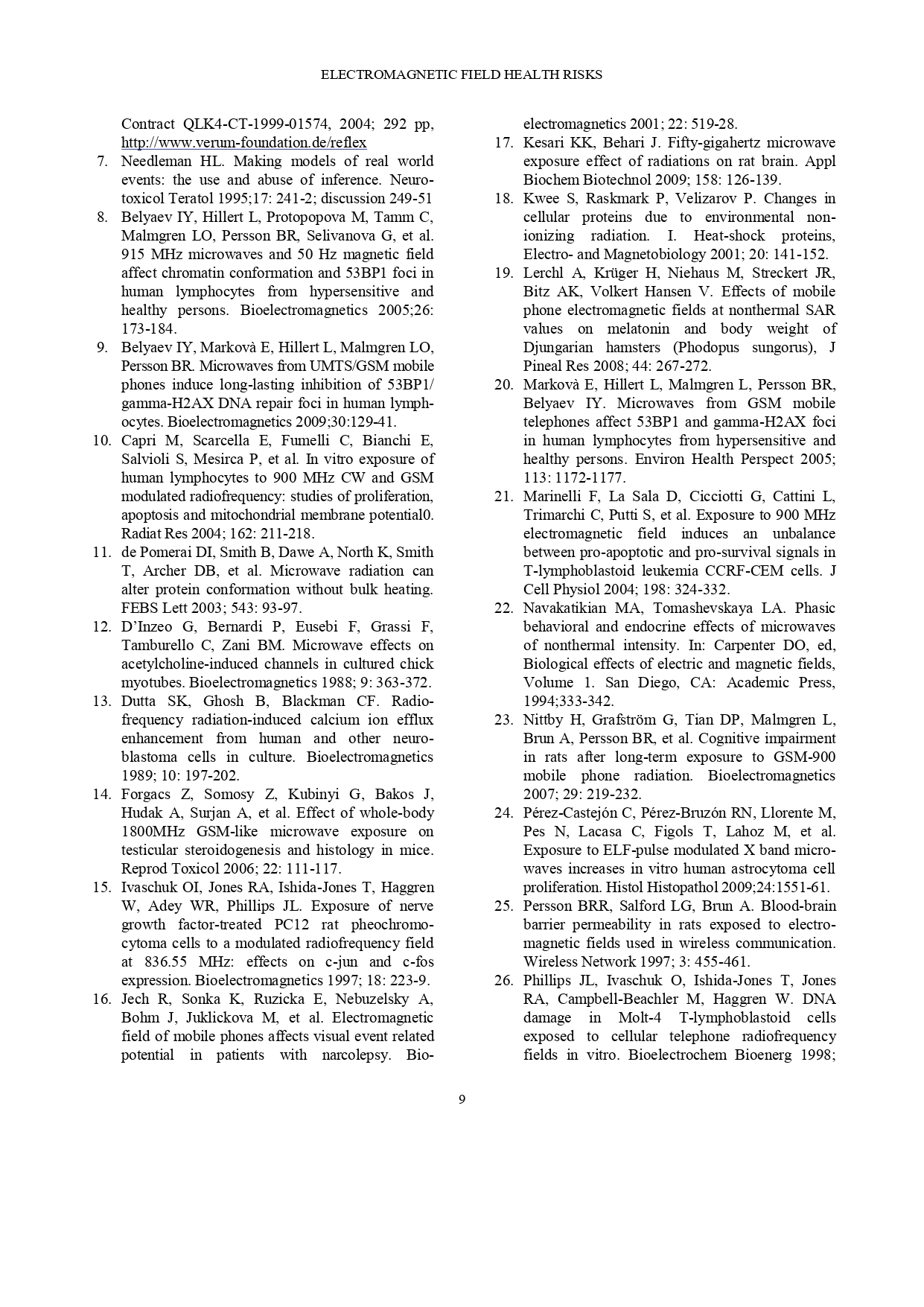
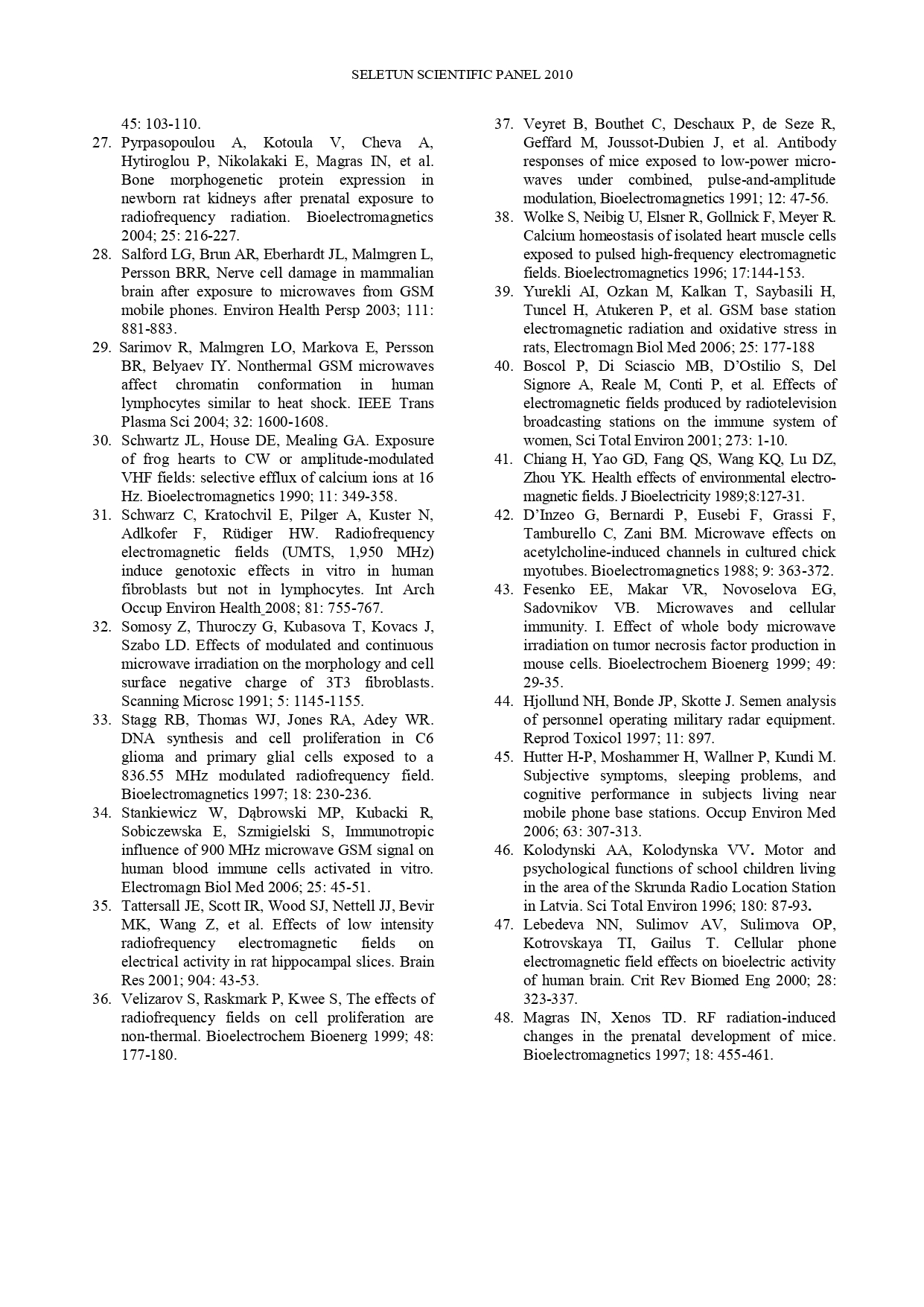
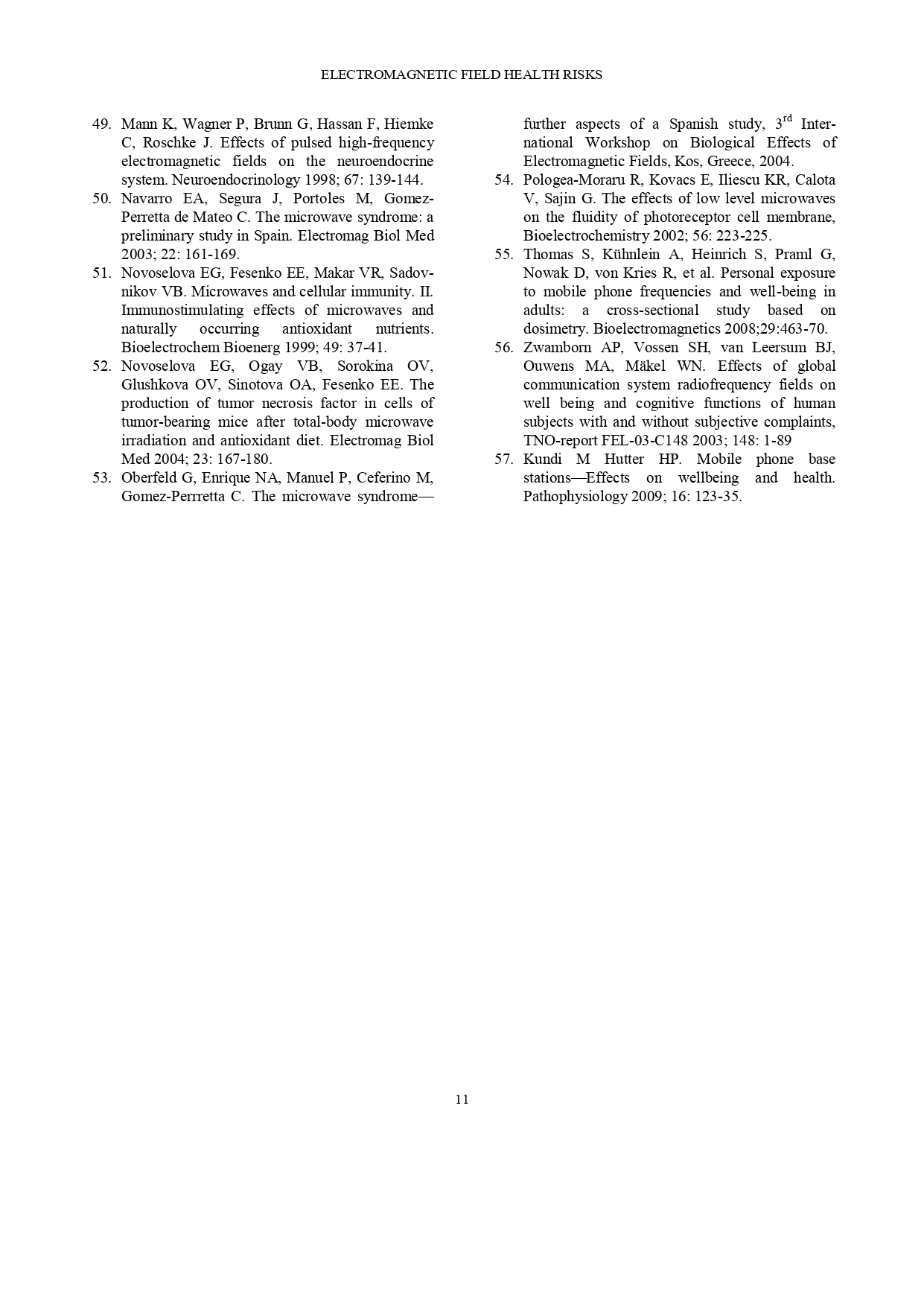
Previous
Next
A summary of the resolution and recommendations of the Seletun Scientific Panel
The report and Consensus Statement, published in the journal Reviews on Environmental Health include ten Key Points:
- The global populations are insufficiently protected, thus currently at risk;
- Sensitive Populations are extra vulnerable;
- Government actions are urgently warranted now, based on evidence of serious disruption to biological systems;
- The Burden of Proof for the safety of radiation-emitting technologies should fall on Producers and Providers, not Consumers;
- EMF Exposures should be reduced in advance of complete understanding of mechanisms of action;
- The current operative measure of Radiation Risk — the Specific Absorption Rate (SAR) — is inadequate, and misguides on safety and health risks;
- An international Disease Registry is needed to track Time Trends of the incidence of Illnesses to correlate the illnesses with exposures;
- Pre-market health testing and safety demonstration is needed for all radiation-emitting technologies;
- Parity is needed for occupational exposure standards, compared to those for the general public;
- Persons with Electrohypersensitivity need the classification Functionally Impaired.
“The Seletun Scientific Panel has adopted a Consensus Agreement that recommends preventative and precautionary actions that are warranted now, given the existing evidence for potential global health risks. We recognize the duty of governments and their health agencies 1) to educate and warn the public, 2) to implement measures balanced in favor of the Precautionary Principle, 3) to monitor compliance with directives promoting alternatives to wireless, and 4) to fund research and policy development geared toward prevention of exposures and development of new public safety measures as well as new, safer communications technologies”, stated Dr. Olle Johansson in a video presentation.
In addition, the Seletun Panel recommended global governments adopt specific exposure guidelines to protect public health and the health of future generations:
Extremely Low Frequency Fields:
- Exposure Limit Recommended. Based on the available evidence, the Seletun Scientific Panel recommends a 0.1 uT (1 mG) exposure limit for extremely low frequency (fields from electrical power) for all new installations, such as powerlines, indoor electric appliances, house-hold items, TVs, radios, computers, and telecommunication devices, based on findings of risk for leukemia, brain tumours, Alzheimer’s, ALS, sperm damage and DNA strand breaks. This exposure limit does not include a safety margin, but starts right at the level where hazardous effects are found. The new recommendation is approx. 1,000 — 10,000 times lower than the current ICNIRP/IEEE standards;
- Set-Back Distance. For all newly installed, or newly upgraded electrical power distribution, the Panel recommends a 0.1 uT (1 mG) set-back distance, from residences, hospitals, schools, parks, and playgrounds schools (and similar locations occupied by children) ; this set-back distance easily can amount to 50 meters or more;
- Maximum 24-Hour Exposure Limit. For all newly constructed residences, offices, schools (and other facilities with children), and hospitals there shall be a 0.1 uT (1 mG) max. 24 hour average exposure limit.
Radiofrequency and Microwave Radiation:
Regarding radiofrequency/microwave radiation, the present guidelines, such as IEEE, FCC, and ICNIRP, are not adequate to protect humans from harmful effects of chronic EMF exposure. It is now instead recommended that:
- For whole-body (in vivo experiments) or cell culture-based exposure, 33 µW//kg. It is approx. 2,400 times lower than the current ICNIRP/FCC standards. No further safety margin or provision for sensitive populations, such as immune-compromised patients or persons with the functional impairment electrohypersensitivity, is incorporated. This may need to be lowered in the future.
- The Panel recommends a provisional whole-body (far-field) limit of 1.7 mW/m2 (also = 0.00017 mW/cm2 = 0.17 μW/cm2) by incorporation of an additional 50-fold safety margin applied to the scientific benchmark of 85 mW/m2. This is consistent with both ICNIRP and IEEE/FCC safety factors. This may need to be lowered in the future. (It can be argued that a further 10-fold reduction is not justified since 13 of the 17 studies are already testing for long-term RF exposure. However, considering that the latest human population studies as reported by Kundi & Hutter (2009) do not show effects below 0.5-1.0 mW/m2, it can also then be argued that an additional 10-fold reduction on precautionary grounds is justified. If another 10-fold reduction is applied, the recommended level would then be 0.17 mW/m2 (also 0.000017 mW/cm2 = 0.017 μW/cm2).
The Seletun Scientific Panel acknowledges that numeric limits derived here for new biologically-based public exposure standards are still a billion times higher than natural EMF levels at which all life evolved. It is a serious mistake to believe that we have always lived in man-made electromagnetic fields, such as electrical power, radio, TV, computers, and wireless telecommunication, and therefore should not worry. It was not long ago when people thought that X-rays, radioactivity, strong ultraviolet light, and radar were completely without harm. Nowadays we know much better!
Noxtak’s take
I think this resolution represents a thorough and powerful review by a qualified scientific panel in electrosmog. This statement is based on a set of epidemiological evidence found in studies and papers specifically related to some bands and frequencies. Based on sound fundamentals, the regulations currently in place to regulate exposure are shown to be unhealthy, contrary to what has long been claimed.
This resolution shows us that the so-called safety-limits are not adequate and that, in addition, the ALARA principle is not being complied with when manufacturing and deploying new technologies; in other words, a position in favor of reducing emissions is not being used at all.
So, if we are looking to develop cleaner and less-polluting technologies, it’s necessary to coordinate efforts in order to research, design, and engineer optimized devices in terms of electric and magnetic fields, like the electro-clean standard we propose. There are actual ways to achieve this, but there’s no motivation in academic and industrial niches to make it happen. Also, the public out there is completely unaware of the problem. So, instead of going for a regulations change, how do we motivate big industries to invest millions in clean electronic engineering? In my opinion, that’s where our efforts should be really directed.
The Seletum Statement then proposes to approach local governments to state that, based on scientific criteria, it is more convenient to act according to the precautionary principle and ALARA; so it is necessary to work on implementing new policies that promote the reduction of electromagnetic emissions to as low as reasonably possible.
But this is not only about promoting government policies at the regional level, as an EMF researcher, I think it is necessary to promote this vision in academic niches, as well as at the industrial and corporate level. We need to start by publicly showing that these safety-levels that are currently established are questionable and potentially unsafe.
This resolution is the first awareness step into the carelessness and lack of interest that currently exist around the manufacture of new technologies, and should be used to encourage industries to work on the development of electromagnetically safer and cleaner technologies. This is our particular focus at NOXTAK.
Based on scientific criteria such as this resolution, we seek to promote greater awareness of this problem. In my opinion, this is not about changing the rules that have been already set, this is implausible and unrealistic, but about promoting awareness around the scientific evidence that supports these values are not safe. This is the way to go to achieve cleaner technologies.
Why do I say that it is unrealistic to promote a change in the regulation? The answer is that we are not ready yet. As I mentioned, the first step is to raise awareness in academic niches such as universities, research organizations, and industries about the potential danger of these emissions; then, encourage better urban planning around the implementation of new technologies; finally, promoting a new technology manufacturing standard. Under this criterion, naturally, better and more convenient regulations for the health of users and the environment will be created.
It is important to mention that, even though we created SPIRO to function as a passive filter that does not block or alter the purpose and destination of the electromagnetic waves, at NOXTAK we have been actively working to promote this improvement in technologies to make them cleaner. Our perception of the ideal is that technologies like SPIRO are used to filter the remaining emissions from devices that operate under the principle of “as low as reasonably possible” emissions, so that people can enjoy completely clean technologies.
And yes, it is true that we can scale our technology to fit industrial emission levels without the need of promoting the ALARA principle or a reduction in EMF emissions, but there’s a big difference between what’s possible and what’s TRULY RIGHT. And the right thing for us is -and will always be- to speak up for the creation of more efficient and less-polluting technologies that ensure sustainability and well-being. This is NOXTAK’s vision.

Joaquín Machado
CEO NOXTAK. EMF specialist and researcher. Advisor on green technologies, IoT, and smart cities.
